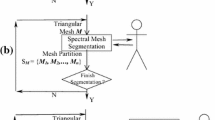Abstract
This paper uses a reverse engineering technique to develop a face sculpture prototype from a real part without an original design documentation. Reproducing the model of a face sculpture becomes a considerable issue in the absence of such a documentation. Therefore, a data point was acquired for generating a 3D face sculpture in computer-aided design. The Delaunay triangulation and mesh of the point cloud were created using the computer-aided three-dimensional interactive application software. The surface of the mesh part was rebuilt, and the generated surface model of the face sculpture was analysed. To fabricate the face sculpture prototype via computer numerical control milling machine, machining simulation was performed using a computer-aided manufacturing software called Mastercam. The simulation showed different surface finishes for the face sculpture prototype when various parameters, such as cutting tool size, step over of the cutting tool and tool path style, were considered.
Access this chapter
Tax calculation will be finalised at checkout
Purchases are for personal use only
Similar content being viewed by others
References
Abu Mansor MS (2006) Free-form surface models generation using reverse engineering technique—an investigation. In: Proceedings of Malaysian Research Group International Conference 2006, United Kingdom, pp 379–385
Bernard A, Véron M (1999) Analysis and validation of 3D laser sensor scanning process. Ann CIRP 48(1):111–114
Budaka I, Hodolic J, Sokovic M (2005) Development of a programme system for data-point preprocessing in reverse engineering. J Mater Process Technol 162:730–735
Carbone V, Carocci M, Savio E, Sansoni G, De Chiffre L (2001) Combination of a vision system and a coordinate measuring machine for the reverse engineering of freeform surfaces. Int J Adv Manuf Technol 17:263–271
Chen YH, Ng CT, Wang YZ (1999) Generation of an STL file from 3D measurement data with user-controlled data reduction. Int J Adv Manuf Technol 152:127–131
Corbo P, Germani M, Mandorli F (2004) Aesthetic and functional analysis for product model validation in reverse engineering applications. Comput Aided Des 36:65–74
Hsiao SW, Chuang JC (2002) A reverse engineering based approach for product form design. Des Stud 24(2):155–171
Lee KH, Woo H (1998) Use of Reverse Engineering method for rapid product development. Comput Ind Eng 35(1):21–24
Lee SH, Kim HC, Hur SM, Yang DY (2002) STL file generation from measured point data by segmentation and delaunay triangulation. Comput Aided Des 34(10):691–704
Masood A, Siddiqui R, Pinto M, Rehman H, Khan MA (2015) Tool path generation, for complex surface machining. Using Point Cloud Data Procedia CIRP 26:397–402
Sansoni G, Docchio F (2004) Three-dimensional optical measurements and reverse engineering for automotive applications. Robot Computer-Integr Manufact 20:359–367
Son S, Park H, Lee KH (2002) Automated laser scanning system for reverse engineering and Inspection. Int J Mach Tools Manuf 42:889–897
Sood S, Duvedi RK, Bedi S, Mann S (2018) 3D representation and CNC machining of 2D digital images. Procedia Manuf 26:10–20
Varaday T, Martin RR, Cox J (1997) Reverse engineering of geometric model—an introduction. Comput Aided Des 29(4):255–268
Vidvans A, Basu S (2018) Smartphone based scalable reverse engineering by digital image correlation. Opt Lasers Eng 102:126–135
Woo H, Kang E, Wang S, Lee KH (2002) A new segmentation method for point cloud data. Int J Mach Tools Manuf 42(2):167–178
Xu L, Lin M, Li J, Wang Z, Chirende B (2008) Three-dimensional geometrical modelling of wild boar head by reverse engineering technology. J Bionic Eng 5:85–90
Yang Z, Chen Y (2005) A reverse engineering method based on haptic volume removing”. Comput Aided Des 37(1):45–54
Zhang Y (2003) Research into the engineering application of reverse engineering technology. J Mater Process Technol 139:472–475
Acknowledgements
This research is supported by the Universiti Sains Malaysia and Ministry of Higher Education Malaysia under the Research University Grant (No: 811118) and Fundamental Research Grant Scheme (FRGS) (Reference No.: 6071369).
Author information
Authors and Affiliations
Corresponding author
Editor information
Editors and Affiliations
Rights and permissions
Copyright information
© 2020 Springer Nature Singapore Pte Ltd.
About this paper
Cite this paper
Mohd Tahar, M.Z.A., Abu Mansor, M.S. (2020). Development of a Face Sculpture Prototype Using a Reverse Engineering Technique. In: Emamian, S.S., Awang, M., Yusof, F. (eds) Advances in Manufacturing Engineering. Lecture Notes in Mechanical Engineering. Springer, Singapore. https://doi.org/10.1007/978-981-15-5753-8_31
Download citation
DOI: https://doi.org/10.1007/978-981-15-5753-8_31
Published:
Publisher Name: Springer, Singapore
Print ISBN: 978-981-15-5752-1
Online ISBN: 978-981-15-5753-8
eBook Packages: EngineeringEngineering (R0)




